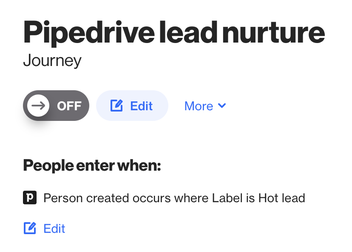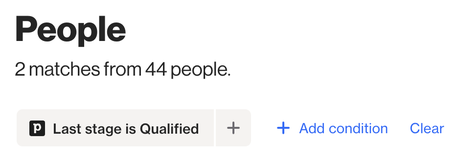Using Pipedrive in Ortto
This page helps you discover how you can get the most out of your Pipedrive integration with Ortto’s filters, reports, and campaigns.
Filters
The Pipedrive activities, person (contact) and organizations fields that are added to your Ortto account can be used anywhere you can create a filter (such as in campaigns, to create an audience, or just to view a segment of people), as well as in reports and dashboards.
Use Pipedrive activities and person fields as filter conditions:
- In a journey as an entry criteria when an activity occurs. For example, you could add people to lead nurture journey when they are created as a record with the label "Hot lead".

TIP: Using an occurs condition gives you a fresh data set, as people enter the journey when they perform the specified activity (as opposed to using has occurred, which qualifies people who have already performed an activity).
In the journey you could add a Condition shape to notify the sales team when a lead’s label changes. For example, the condition could be "Person updated has occurred where Label is Cold lead", and if Yes, add an Action shape to notify the sales team via email or Slack.

- To view a segment of people on the People page, such as people who are sitting at a particular stage within a pipeline (a segment from which you can create an audience, send a campaign, export, or archive).

Actions
Actions allow you to use Ortto to update data within a data source.
One way to use Pipedrive actions is to add an Action in a journey or playbook to update a deal.
For example, you could create a journey where the entry criteria is Deal created occurs. With an occurs type entry activity, you can use activity attribute matching throughout the journey to match the deal ID to other activities.
In this example, you might set the journey exit criteria to Deal won occurs and add a clause for contacts to exit when the deal ID matches the entry activity’s deal ID.
Within this journey, you can also apply activity attribute matching to filter and condition shapes. In the below example, the journey has condition shapes that require the contact to be at a particular deal stage, where the deal ID matches the entry deal ID.
Learn more about attribute matching at Matching activity attributes in journeys.
Reports
You can use Ortto’s powerful reports to gain insight into your Pipedrive activities.
Here are some ideas for creating Pipedrive reports.
See your total revenue from won deals
- On the Reports page, click New report.
- Under on the New report page, click Start from scratch.
- For the report type, select a Metric, then click Next.
- Give your report a name then click Add metric.
- For your Metrics:
- choose Deal won for Pipedrive.
- Aggregate by: Sum of attribute
- Attribute for aggregate: Value
- Edit any of the default settings a required, such as adding a revenue Goal,then click Create to view your report.
Create a ledger of new deals, the owner and the amount
- On the Reports page, click New report.
- Under on the New report page, click Start from scratch.
- For the Type, select Ledger, then Next.
- Give your report a name then click Add metric.
- In Metrics, select the activity as Deal created.
- Add Columns such as Time, Name, Value and Owner name, and adjust any other default report settings as required.
- Click Create to view your report.
Learn more about reports in Working with reports.
